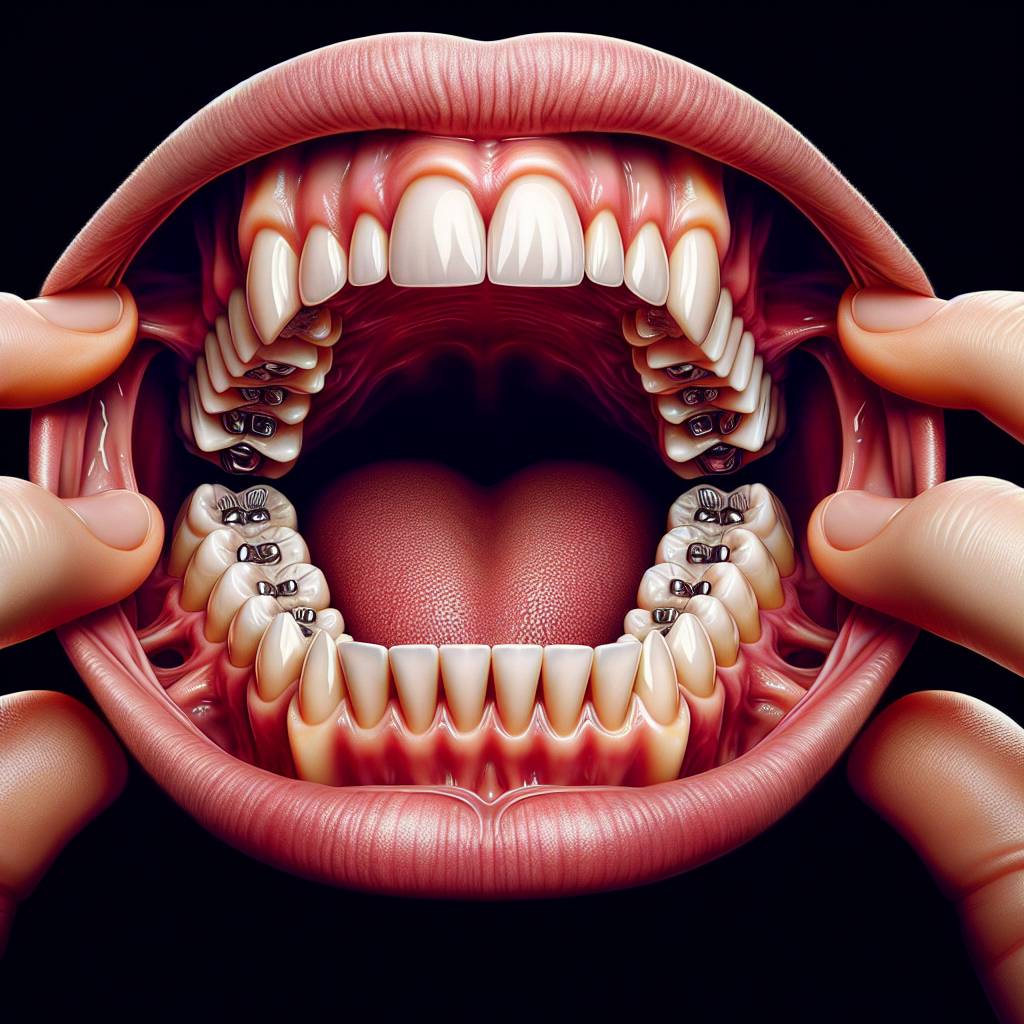Gaps in the teeth, also known as diastema, are a common occurrence among both adults and children. They can occur naturally or be caused by a variety of factors such as thumb-sucking, misaligned teeth, or genetics. While gaps in the teeth may not always be aesthetically pleasing, they can often be corrected with braces or other dental treatments. In this article, we’ll explore some of the causes of gaps in the teeth and discuss how to get rid of them.Identifying gaps in teeth can be done by looking closely at the teeth to check for any spaces between them. If there are any spaces, or gaps, they will usually appear as a dark line between the teeth. It can also be helpful to compare the gap between the teeth to a ruler or another object that has measurements. If the gap appears larger than what is considered a normal distance between two adjacent teeth, then it is likely that there is a gap present. Additionally, if one tooth appears shorter than its adjacent counterparts, it may indicate that there is a gap present.
Causes of Gaps Between Teeth
Gaps between teeth can be caused by a variety of factors. Genetics plays a large role in the development of gaps, as it is the primary influence on the size of teeth and jaw structure. Missing teeth can also cause gaps in between teeth, as can overly crowded teeth, which may be shifted out of their natural positions. Lastly, certain habits such as thumb-sucking or tongue thrusting can cause gaps to appear in between the teeth.
Genetics is one of the most common causes of gaps between teeth. Children who have parents with large spaces between their teeth are more likely to have them as well. Also, certain genetic conditions can cause gaps to develop in between the teeth. These conditions include cleft lips or palates and ectodermal dysplasias, which are disorders that affect how bones and cartilage form in children.
Missing or extracted teeth is another common cause of gaps between the remaining ones. When a tooth is missing from a dental arch, it creates an imbalance that pushes surrounding teeth outward into empty spaces. This is why it’s important to replace missing teeth with bridges or implants as soon as possible to prevent spaces from forming due to shifting and overcrowding.
Overcrowding in the mouth can also cause spaces to appear between the natural teeth because there isn’t enough room for all of them to fit properly inside the dental arch. When this happens, some of them may be pushed outward instead of inward like they should be resulting in an uneven smile with visible gaps in between some areas. Orthodontic treatment such as braces can help correct overcrowding and shift all the teeth back into their correct positions reducing any visible spaces that may have been present before treatment started.
Lastly, certain habits such as thumb-sucking or tongue thrusting can create gaps in between the front upper and lower incisors due to putting excessive pressure on them over time that changes their alignment slightly and creates small spaces where there shouldn’t be any. These habits should be broken as soon as possible before they begin affecting your child’s smile or speech development negatively by creating larger spaces that cannot be fixed without more intensive orthodontic treatment such as braces or Invisalign® aligners.
Prevention of Gaps in Teeth
Gaps in teeth can have an impact on the appearance of your smile. To prevent gaps from forming between your teeth, it is important to practice good oral hygiene and maintain regular dental visits. Brushing and flossing your teeth twice a day will help keep them clean and free of debris that can cause gaps to form. Additionally, visiting your dentist regularly for checkups and professional cleanings can help identify any potential issues before they become more serious. Your dentist may recommend using orthodontic treatments such as braces or aligners to correct any misalignment that could lead to gaps in your teeth.
In some cases, lifestyle habits may be contributing to gaps in teeth. If you are a smoker or if you drink alcohol heavily, these habits can increase the risk of developing gaps in your teeth over time. Quitting smoking and cutting down on the amount of alcohol you consume can help reduce the chances of developing gaps in your teeth. Eating a healthy diet that is rich in essential vitamins and minerals can also help ensure that your teeth remain strong and gap-free.
Gaps between teeth can be an aesthetic concern for many people, but they don’t have to be permanent. By practicing good oral hygiene habits, visiting the dentist regularly, and making changes to lifestyle habits if necessary, you can help prevent gaps from forming or worsening over time.
Treatments for Gaps Between Teeth
Gaps between teeth, also known as diastema, are a common problem and can occur between any two teeth in the mouth. Diastema can be caused by several factors, such as genetics, improper oral hygiene, or misalignment of the teeth. It can affect your appearance and cause difficulty with certain types of food. Fortunately, there are treatments available to reduce the size of gaps between teeth.
The most common treatment for diastema is orthodontic treatment, such as braces or clear aligners. Braces and clear aligners work by gradually shifting the position of the teeth to close gaps and create a more even smile. This process usually takes anywhere from six months to two years depending on the severity of the case.
Another option for reducing gaps between teeth is bonding or veneers. Bonding involves applying a composite material to the front surface of a tooth to fill in gaps and reshape it. Veneers are thin shells made of porcelain or composite material that fit over the front surface of a tooth to improve its shape and size. Bonding and veneers are both effective treatments for closing gaps between teeth, but they typically require multiple visits to complete and may need to be replaced every few years due to wear and tear.
Gum grafting is another option for closing gaps between teeth. During this procedure, tissue from another area in your mouth is transplanted into the gap between your teeth so that it can fill in any missing gum tissue or bone that might be causing the gap. Gum grafting is typically used when other treatments have not been successful in closing gaps between teeth due to receding gums or other factors.
No matter which treatment you choose for reducing gaps between your teeth, it’s important that you maintain good oral hygiene practices such as brushing and flossing regularly in order to maintain healthy gums and avoid any further damage that could lead to larger gaps between your teeth.
Overall, there are various options available for reducing gaps between your teeth depending on what works best for you and what kind of results you’re looking for.
If you are considering any type of treatment for diastema, it is important that you speak with an experienced dentist who can evaluate your individual situation and recommend a course of action that is right for you.
Orthodontic Treatments for Gaps in Teeth
Gaps between teeth, also known as diastema, can be an unsightly cosmetic issue. Not only can it affect your smile, but it can also lead to more serious dental health problems. Fortunately, there are orthodontic treatments available that can help close the gaps in your teeth.
The most common treatment for small gaps in the teeth is a bonded retainer or a fixed wire retainer. It is a thin piece of wire that is permanently attached to the back of the teeth and helps to keep them aligned. The retainer will need to be adjusted periodically to make sure it stays in place and continues to do its job properly.
In some cases, a dental bridge or crown may be used to fill in gaps between teeth. This involves placing a false tooth in between two existing teeth in order to close the gap. It is usually made of porcelain and is permanently bonded into place.
Another option for closing gaps between teeth is braces. Braces are usually recommended for more severe cases where the gap has been caused by misalignment of the teeth and jaw. They are used to slowly move the teeth into their correct positions over time until the gap has been closed completely.
Invisalign is another option for filling gaps between teeth that has grown increasingly popular in recent years due to its discreet nature and comfortability compared to traditional braces. Invisalign uses clear plastic aligners that fit over the teeth like mouthguards and gradually move them into place over time without any metal wires or brackets being visible on your smile.
No matter which orthodontic treatment you choose, it’s important to understand what you’re getting into before making any decisions as these treatments can take several months or even years before they are complete. However, with patience and proper care, you can finally have that beautiful smile you’ve always wanted!

Pros of Orthodontic Treatments for Gaps in Teeth
Orthodontic treatments are a great way to close gaps in teeth and improve the overall look and feel of your smile. Orthodontic treatments are also beneficial for improving your bite, which is important for overall dental health. One of the primary advantages of orthodontic treatment is that it can be done in a relatively short amount of time, typically lasting between six months and two years. The process is also non-invasive, meaning there are no incisions or other invasive procedures involved. In addition, orthodontic treatments can realign teeth that have been misaligned due to crowding or other reasons. Finally, orthodontic treatments can help to improve facial aesthetics by making the smile appear more symmetrical and balanced.
Cons of Orthodontic Treatments for Gaps in Teeth
Although there are many advantages to orthodontic treatments for closing gaps in teeth, there are also some potential drawbacks as well. The primary disadvantage is the cost associated with these types of treatments; they can be quite expensive depending on the severity of the problem being addressed. In addition, orthodontists may require multiple visits over a period of time before a final result is achieved. Furthermore, some people may experience pain or discomfort during the treatment process as their teeth move into alignment. Finally, although braces can be used to correct gaps in teeth, they may not be able to address more serious issues such as overcrowding or malocclusion (misalignment) that requires surgery.
Dental Bonding for Closing Gaps between Teeth
Dental bonding is a popular cosmetic dentistry option for closing gaps between teeth. This procedure involves the application of a tooth-colored composite resin material to the affected tooth or teeth. The resin material is applied by an experienced dentist in order to fill in any gaps or reshape teeth that are misshapen or discolored. The results are dramatic and very natural looking, and the process can be done quickly and fairly inexpensively.
Dental bonding is typically used to close gaps between front teeth, although it can also be used on other teeth as well. The procedure begins with a thorough cleaning of the affected area. Next, the dentist will apply an etching solution to the area in order to roughen up the surface of the tooth and provide a better surface for the bonding material to adhere to. Once this is done, a special bonding liquid is applied and allowed to dry before a putty-like composite material is applied and smoothed out until it takes on the desired shape.
The composite resin material is then cured with a special light that hardens it into place. Finally, it’s polished and buffed so that it perfectly matches the color of your surrounding teeth. The entire process usually takes less than an hour, depending on how many teeth need to be corrected. Dental bonding can last up to 10 years with proper care and regular dental checkups.
Overall, dental bonding is an excellent option for closing gaps between your teeth quickly and easily. It’s an affordable way to improve your smile without breaking the bank, and it’s one of the least invasive cosmetic dentistry procedures available today. If you’re looking for a way to close gaps between your teeth without spending too much time or money, dental bonding might be right for you!
Closing Gaps between Teeth with Porcelain Veneers
Gaps between teeth can be a source of embarrassment and insecurity for many people. These gaps can make it difficult to bite and chew, which can lead to other health problems. Luckily, porcelain veneers are an effective solution for closing gaps between teeth. Porcelain veneers are thin pieces of porcelain that are designed to fit over the front surface of the teeth. They are customized to fit each individual’s mouth and provide a natural-looking smile.
The process for getting porcelain veneers begins with an initial consultation with your dentist. During this appointment, they will examine your mouth and take X-rays to ensure that there is enough healthy tooth structure remaining in order to place the veneers properly. Your dentist will also discuss the options available to you for closing the gaps between your teeth.
Once you have decided on the best option for closing the gaps in your teeth, your dentist will begin preparing the teeth for veneers by removing a small amount of enamel from each tooth that will be receiving a veneer. This is done in order to make room for the thickness of the veneer material.
Once your teeth have been prepared, an impression of your mouth will be taken and sent off to a dental laboratory where your custom-made porcelain veneers will be created. While you wait for your new veneers, you may need to wear temporary ones in order to protect any exposed areas of tooth enamel while you wait for them.
When your new porcelain veneers arrive at the dental office, they will be carefully bonded onto each tooth with dental cement or adhesive resin. Your dentist will then use a special light or laser beam to harden or cure the cement or resin so that it securely holds each veneer in place. Finally, they may perform some final adjustments and polishing so that it looks and feels natural in your mouth.
Porcelain veneers can provide an excellent solution for closing gaps between teeth and restoring confidence in one’s smile. The process is relatively simple and painless, making it a great option for anyone looking to improve their smile without undergoing extensive dental work such as braces or orthodontic surgery. If you’re thinking about getting porcelain veneers, talk to your dentist today about what’s involved in this quick and easy procedure!

Conclusion
Gaps in teeth can be caused by a variety of factors, including genetics, poor dental hygiene, and injuries. Some gaps may be treated with braces or other orthodontic treatments, while others may require more complex dental treatments such as implants or bridges. It is important to visit your dentist regularly to determine the best treatment option for your particular needs. Taking good care of your teeth with regular brushing and flossing can help prevent gaps from occurring in the first place.
Ultimately, if you have gaps in your teeth, it is important to seek the advice of a qualified dentist who can help you determine the best course of action. With the right care and treatment plan, you can maintain a healthy and attractive smile for years to come.

